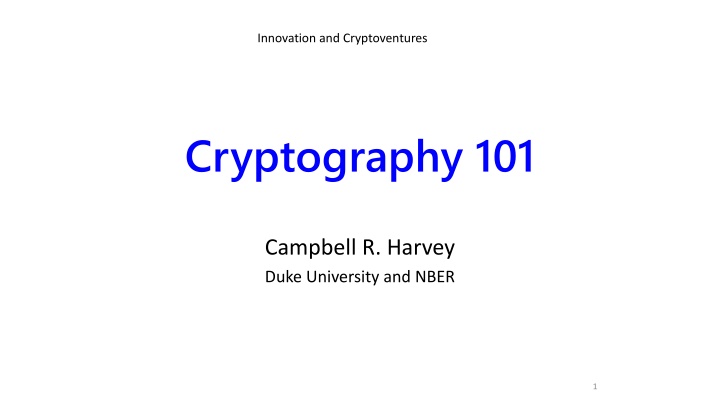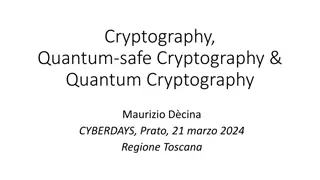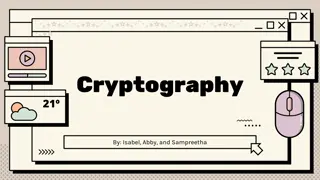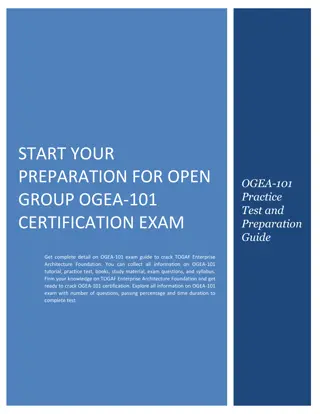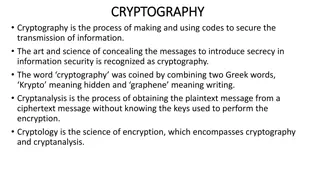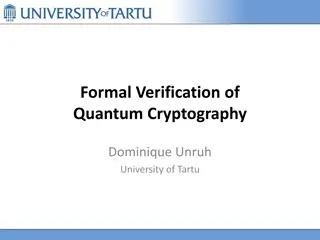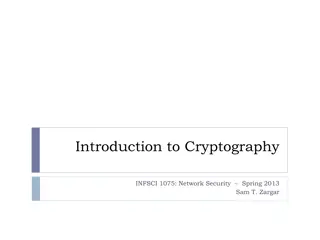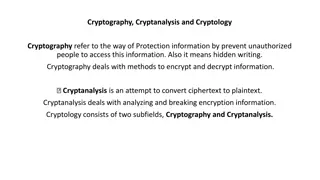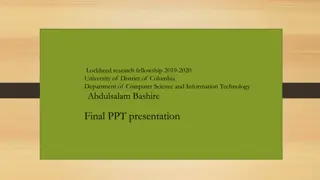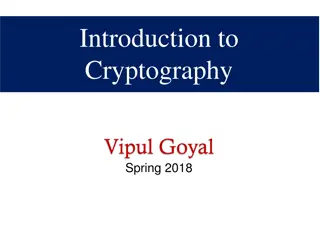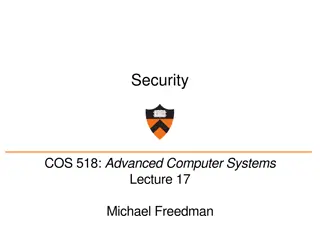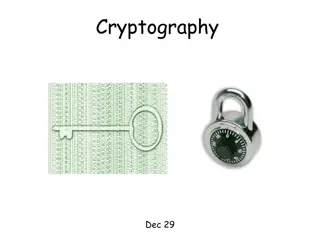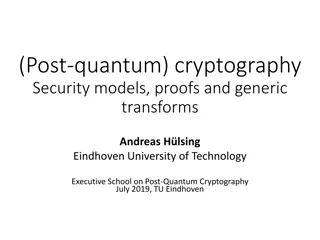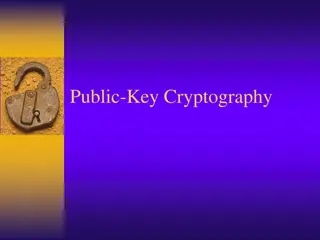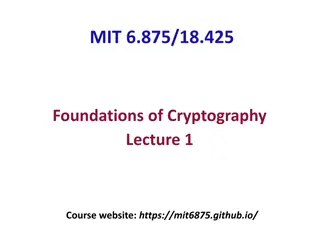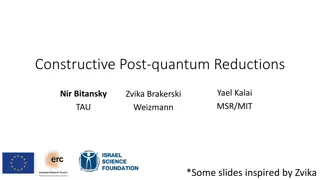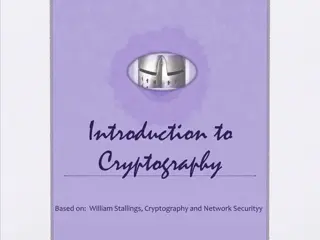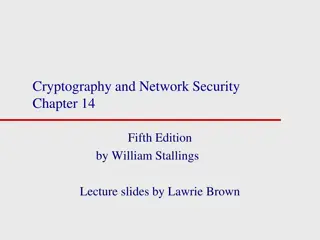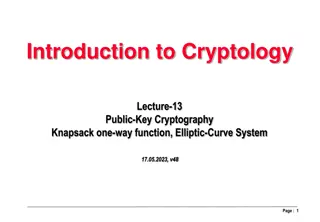Cryptography 101
Cryptography is the art of secure communication in the presence of adversaries. It involves encrypting and decrypting messages, protecting information from eavesdroppers, and ensuring data integrity. Learn about symmetric and public key encryption, adversary goals, early encryption methods, and key exchange breakthroughs in this comprehensive guide by Campbell R. Harvey.
Download Presentation

Please find below an Image/Link to download the presentation.
The content on the website is provided AS IS for your information and personal use only. It may not be sold, licensed, or shared on other websites without obtaining consent from the author.If you encounter any issues during the download, it is possible that the publisher has removed the file from their server.
You are allowed to download the files provided on this website for personal or commercial use, subject to the condition that they are used lawfully. All files are the property of their respective owners.
The content on the website is provided AS IS for your information and personal use only. It may not be sold, licensed, or shared on other websites without obtaining consent from the author.
E N D
Presentation Transcript
Innovation and Cryptoventures Cryptography 101 Campbell R. Harvey Duke University and NBER 1
Definition Cryptography is the science of communication in the presence of an adversary. Part of the field of cryptology. Campbell R. Harvey 2018 3
Goals of Adversary Alice sends message to Bob Eve is the adversary Campbell R. Harvey 2018 4
Goals of Adversary Eve s goals could be: 1. Eavesdrop 2. Steal secret key so that all future messages can be intercepted 3. Change Alice s message to Bob 4. Masquerade as Alice in communicating to Bob Campbell R. Harvey 2018 5
Symmetric and Public Key Early algorithms were based on symmetric keys. This meant a common key encrypted and decrypted the message You needed to share the common key and this proved difficult Campbell R. Harvey 2018 6
Early methods Early methods relied on a shared key or code A message would be encrypted and sent but the receiver needed to decode with a key or a special machine Example: The Lektor in James Bond, From Russia with Love. Campbell R. Harvey 2018 7
Early methods However, you needed to securely share the key or decoder. Campbell R. Harvey 2018 8
Early methods However, you needed to securely share the key or decoder. The adversary Campbell R. Harvey 2018 9
Early methods Nazi Enigma Machine https://www.youtube.com/watch?v=G2_Q9FoD-oQ https://www.youtube.com/watch?v=V4V2bpZlqx8 Campbell R. Harvey 2018 10
Key Exchange Breakthrough in 1976 with Diffie-Hellman-Merkle key exchange There is public information that everyone can see. Each person, say Alice and Bob, have secret information. The public and secret information is combined in a way to reveal a single secret key that only they know https://www.youtube.com/watch?v=YEBfamv-_do Campbell R. Harvey 2018 11
Key Exchange Paint example: Campbell R. Harvey 2018 12
Key Exchange Numerical example Need to know some Modulo arithmetic 5 mod 2 = 1 Divide 5 by 2 the maximum number of times(2) 2 is the modulus The remainder is 1 Remainders never larger than (mod-1) so for mod 12 (clock) you would never see remainders greater than 11. Campbell R. Harvey 2018 13
Key Exchange For our application, we will consider special case. Let p=prime number and let g be the generator (or primitive root) g is a primitive root of p if we consider n=1, (p-1) and gn mod p goes through all the numbers, 1 to (p-1) in some order. Going through all the numbers 1-(p-1) means each one is equally probable Better with example! Campbell R. Harvey 2018 14
Key Exchange Example: 3 is a primitive root of 5 p: g: 5 3 n 1 2 3 4 g^n g^n mod p 3 4 2 1 3 9 27 81 All numbers <p in no particular order n goes from 1 to (p-1)=4 Campbell R. Harvey 2018 15
Key Exchange Example: 3 is a primitive root of 5 p: g: 5 3 n 1 2 3 4 5 6 7 8 9 10 11 12 13 14 15 16 g^n g^n mod p 3 4 2 1 3 4 2 1 3 4 2 1 3 4 2 1 Campbell R. Harvey 2018 3 9 27 81 243 729 2187 6561 19683 59049 177147 531441 1594323 4782969 14348907 43046721 All numbers <p and they repeat 16
Key Exchange Example: 4 is not a primitive root of 5 p: g: 5 4 n 1 2 3 4 g^n g^n mod p 4 1 4 1 2, 3 are missing 4 16 64 256 Campbell R. Harvey 2018 17
Key Exchange Aside (can t resist): Fermat s Little Theorem: gp-1 = 1 mod p if p=prime and g is not zero Our prev. example: 35-1 = 1 mod 5 p: g: 5 3 n 1 2 3 4 g^n g^n mod p 3 4 2 1 3 9 27 81 Fermat Campbell R. Harvey 2018 18
Key Exchange Aside (can t resist): Fermat s Little Theorem: gp-1 = 1 mod p if p=prime and g is not zero Our prev. example: 34 = 1 mod 5 p: g: 17 5 n 1 2 3 4 5 6 7 8 9 10 11 12 13 14 15 16 g^n g^n mod p 5 8 6 13 14 2 10 16 12 9 11 4 3 15 7 1 p: g: 5 3 5 25 125 625 3125 15625 78125 390625 1953125 9765625 48828125 244140625 1220703125 6103515625 30517578125 1.52588E+11 n 1 2 3 4 g^n g^n mod p 3 4 2 1 3 9 27 81 Fermat Campbell R. Harvey 2018 19 https://www.youtube.com/watch?v=XPMzosLWGHo&feature=youtu.be
Key Exchange Aside 2 (can t resist 2): Fermat s Last Theorem: No three positive integers, a, b, c can solve an + bn = cn for any n>2 Conjectured in 1637 Proven by Andrew Wiles 358 years later in 1994! The proof uses Elliptic Curve math which we will talk about later. See Numberphile video https://www.youtube.com/watch?v=qiNcEguuFSA Also great video on Riemann Hypothesis: https://www.youtube.com/watch?v=qiNcEguuFSA Also the Poincare conjecture https://www.youtube.com/watch?v=GItmC9lxeco Campbell R. Harvey 2018 20
Key Exchange Mechanics Public information in blue Alice secret information in green Bob secret information in purple Shared secret in red 1. Alice and Bob agree to use prime number p=23 and base (generator) g=5. Campbell R. Harvey 2018 21
Key Exchange 2. Alice chooses a secret integer, a=6. 3. Alice sends Bob A=ga mod p or 56 mod 23 = 8 p: g: 23 5 n 1 2 3 4 5 6 7 8 9 10 11 12 13 14 g^n g^n mod p 5 2 10 4 20 8 17 16 11 9 22 18 21 13 5 25 125 625 3125 15625 78125 390625 1953125 9765625 48828125 244140625 1220703125 6103515625 Note sending Bob the number 8 does not reveal Alice s secret number because 8 will repeat many times Campbell R. Harvey 2018 22
Key Exchange p: g: 23 5 4. Bob chooses a secret integer, b=15. 5. Bob sends Alice B=gb mod p or 515 mod 23 = 19 n 1 2 3 4 5 6 7 8 9 10 11 12 13 14 15 g^n g^n mod p 5 2 10 4 20 8 17 16 11 9 22 18 21 13 19 5 25 125 625 3125 15625 78125 390625 1953125 9765625 48828125 244140625 1220703125 6103515625 30517578125 Note sending Alice the number 19 does not reveal Bob s secret number because 19 will repeat many times Campbell R. Harvey 2018 23
Key Exchange 6. Alice calculates s=Ba mod p or s=196 mod 23 = 2 p: g: 23 19 n 1 2 3 4 5 6 g^n g^n mod p 19 16 5 3 11 2 19 361 6859 130321 2476099 47045881 Campbell R. Harvey 2018 24
Key Exchange 7. Bob calculates s = Ab mod 23 or s=815 mod 23 = 2 8. Alice and Bob now share a common secret even though neither know each others individual secret numbers. In practice, the prime number is picked to be 300 digits and the a and b are 100 digits long The generator, g, is usually small 9. Now Alice can encrypt a message for Bob and Bob has the key to decrypt and vice versa! Campbell R. Harvey 2018 25
Key Exchange The modulo arithmetic is the key. Think of starting 10 years ago and accumulating time in minutes (5,258,880 minutes). Suppose you took a picture of a clock at various times during the 10 years. Campbell R. Harvey 2018 26
Key Exchange The modulo arithmetic is the key. The clock says 1:50. However, you don t know AM/PM or which of the days Campbell R. Harvey 2018 27
RSA Very popular method of encryption called RSA* The basic algorithm multiplies two prime numbers Multiplication is easy However, given the product, it is extremely hard to factor the number Important in cryptography is have a large gap between the ease of encryption and the difficulty in decryption (called trapdoor functions ) Initials of Ron Rivest, Adi Shamir, and Leonard Adleman. Discovered earlier by the UK Communications-Electronics Security Group (CESG). Campbell R. Harvey 2018 28
RSA The insight is that encryption done with the public key can only be undone with the private key This is different from (but related to) the previous example where there was a common secret number Now each person will have a public and private key https://www.youtube.com/watch?v=wXB-V_Keiu8 Campbell R. Harvey 2018 29
RSA Computers have problems with very large numbers hence we will rely on modulo arithmetic. In RSA, you set a max number which is the product of two prime numbers this is exactly the modulus (what you divide by, or in our clock example, it would be 12x60=720 minutes) My clock example is not a good one for encryption because the two numbers are secret that produce the max (and 12 and 60 are not prime) Campbell R. Harvey 2018 30
RSA The public and private keys are less than the max and greater than zero To encrypt, take a number and raise it to the power of the public key and apply mod max . To decrypt, take the resultant number and raise it to the power of the private key and apply mod max You get back the original number! Example! Campbell R. Harvey 2018 31
RSA Let s take 7 and 13 as prime numbers and the max will be 91. 7 and 13 are secret but 91 is public knowledge We will choose a public key of 5 Given the public key and the 7 and 13, this implies a private key of 29. I will prove this but take my word for now. First, let s do a simple encryption. Campbell R. Harvey 2018 32
RSA Let s choose to encrypt the number 2 given our max is 91. Apply the public key to it: 25=32 32 mod 91 = 32 To decrypt, we will have to calculate 3229 mod 91 which is the same as (25)29=2145(remember exponent of exponent you multiply) This an enormous number: 10 followed by 41 zeros! Campbell R. Harvey 2018 33
RSA Need to apply some tools First, xy mod 91 = (x mod 91)(y mod 91) mod 91 Second, 2145=2128217 (multiplying exponents of same base means you add them up) Third, we need a way to calculate 2128 mod 91 Campbell R. Harvey 2018 34
RSA Note: using mod function in excel mod= 91 2^1 2^2 2^4 2^8 2^16 2^32 2^64 2^128 2 4 2 4 16 256 16 74 16 74 16 74 65536 not needed not needed not needed Key is 28 mod 91 = (24 mod 91)(24 mod 91) = 16x16 mod 91 = 256 mod 91 = 74 216 mod 91 = (28 mod 91)(28 mod 91) = 74x74 mod 91 =16 So only need 8 calculations not 128! Campbell R. Harvey 2018 35
RSA Now we are almost done 2145mod 91 = (2128 mod 91)(216 mod 91)(21 mod 91) = 74 x 16 x 2 = 2368 mod 91 = 2 Hence, we have decrypted our secret number! Campbell R. Harvey 2018 36
RSA There are some missing links. First, it should be clear that there is a mathematical relation between the private key and the public key. Second, how do we set the private key (one that will decode) given the public key. My goal is to give you a basic understanding. Note that cryptography is a huge field where you could take dozens of courses. Campbell R. Harvey 2018 37
RSA (optional) For many of you, this will be a review. We will do simplified versions of some methods proposed by Euclid in 300BC. While my examples are simple examples, the method is algorithmic and easily coded up to make more complex examples doable. We will cover greatest common denominator and The Euclidian Algorithm as well as The Extended Euclidian Algorithm Campbell R. Harvey 2018 38
RSA (optional) Division Algorithm for Integers Let s start simple: 13 divided by 5 We can decompose the division into two parts 13/5 = 2 ("the quotient") + 3/5 ("the remainder"). We can express this in terms of integers, without reference to the division operation: 13 = 2(5) + 3. Campbell R. Harvey 2018 39
RSA (optional) Division Algorithm for Integers More formally stated: If a and b are positive integers, there exist integers unique non- negative integers q and r so that a = qb + r , where 0 r < b. q=quotient r=remainder Campbell R. Harvey 2018 40
RSA (optional) Greatest common denominator This one I know every one has done before If I give you two numbers, say, 5 and 15, and ask what the greatest common denominator is, most of you will say 5 5 is the largest number that divides evenly into both of these numbers 1 is another candidate but it is not the greatest So gcd(5,15)=5 Campbell R. Harvey 2018 41
RSA (optional) Euclidian Algorithm Finding the gcd of 81 and 57 by the Euclidean Algorithm: 81 = 1(57) + 24 (divide larger by smaller) 57 = 2(24) + 9 (the r in above now b ) 24 = 2(9) + 6 9 = 1(6) + 3 (the gcd is the r of second 6 = 2(3) + 0. last line) Hence, gcd(81,57)=3 (also an Excel function!) Campbell R. Harvey 2018 42
RSA (optional) Euclidian Algorithm It is well known that if the then there exist integers p and s so that: p(a) + s(b) = r Relevance check We will be using above equation to link the private and public keys In our case, the gcd of two prime numbers = 1 so r=1 gcd(a, b) = r Campbell R. Harvey 2018 43
RSA (optional) Extended Euclidian Algorithm Let s go back to 81 and 57 p(a) + s(b) = r p(57) + s(81) =3 Let s solve for the p and the s Again, it is a bit awkward but note the algorithmic nature of the solution Campbell R. Harvey 2018 44
RSA (optional) 81 = 1(57) + 24 57 = 2(24) + 9 24 = 2(9) + 6 9 = 1(6) + 3 or rearranging 24 = 81 - 1(57) 9 = 57 - 2(24) 6 = 24 - 2(9) 3 = 9 - 1(6) 3 = 9 -1(6) (start with last line) 3 = 9 - 1(24 -2(9)) (sub for 6 2nd last line) 3 = 3(9) -1(24) (rearrange above) 3 = 3(57 - 2(24)) -1(24) (sub for 9 3rd last) 3 = 3(57) - 7(24) (rearranged) 3 = 3(57) - 7(81 - 1(57)) (sub for 24 4th last) 3 = 10(57) - 7(81) (rearranged) We are done: p=10; s=-7 Campbell R. Harvey 2018 45
RSA (optional) Deriving the private key We know pq=N; p=7; q=13; N=91; public key=5. How do we get the private key 29? Campbell R. Harvey 2018 46
RSA (optional) RSA: Select prime numbers p and q where p q: 7, 13 N= max = pq; N will be modulus: 91 Introduce a simple function: (n)=(p-1)(q-1) 72=6x12 Choose public encryption exponent, e, such that gcd(e, (p-1)(q-1))=1 [in our case 5] Campbell R. Harvey 2018 47
RSA (optional) RSA: Verify gcd(e, (p-1)(q-1))=1 with Extended Euclidian Algorithm and also determine the decryption key d Campbell R. Harvey 2018 48
RSA (optional) RSA: Use Euclidian Algorithm to show gcd(72,5)=1 72 = 14(5) + 2 5 = 2(2) + 1 gcd 2 = 2(1) + 0 Campbell R. Harvey 2018 49
RSA (optional) 72 = 14(5) + 2 5 = 2(2) + 1 1 = 5 -2(2) (start with last line) 1 = 5 - 2(72 -14(5)) (sub for 2) 1 = 29(5) -2(72) (rearrange above) or rearranging 2 = 72 - 14(5) 1 = 5 - 2(2) We are done: d=29. Campbell R. Harvey 2018 50
